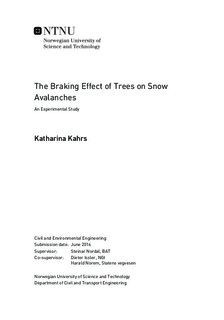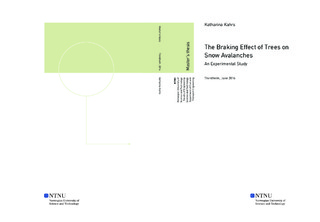| dc.description.abstract | Mountain forests can protect people and infrastructure from snow avalanches in a cost-effective way. In this thesis, we have carried out a series of small-scale chute experiments to study the braking effect of trees on snow avalanches. We assume that the avalanche releases above the forest and that the trees are not broken or bent upon impact of the avalanche.
The chute consists of three straight sections: an upper or acceleration section 0.2 m wide and 1.5 m long, a middle or forest section 1.0 m wide and 2.0 m long consisting of three aluminium plates with a rectangular grid of pre-drilled holes, and a lower or runout zone 1.0 m wide and 2.0 m long. The inclination of both the upper and the middle section is 35°, while the lower section is inclined at 10°. The avalanche is released from a container at the top of the upper section. The snow is modelled by glass beads (ballotini) with a diameter of 0.1 mm. The trees are modelled by metal pins that are inserted into the aluminium plates in computer-generated random patterns. The experiments were filmed from above and from the side with a frame rate of 60 fps.
A total of 54 experiments have been carried out: twelve reference experiments without a
forest, of which six were carried out at the beginning and six at the end of the study, and 42 experiments with a forest. We have varied the following three parameters: the velocity at which the avalanche hits the forest (incident front velocity), the stem diameter of the trees, and the forest density. The incident front velocity was varied by varying the mass of the avalanche. Three different masses of ballotini were used: 2 kg, 4 kg, and 6 kg. We used two different stem diameters. The metal pins with a diameter of 3.2 mm were used as the thinner trees. For the thicker trees, plastic tubes with an outer diameter of 6 mm were threaded onto the metal pins. The forest
density was varied by varying the number of metal pins inserted into the aluminium plates. The forest density is 100% if there is a metal pin inserted into every pre-drilled hole. Four different densities were used: 10%, 25%, 50%, and 90%. We have measured the front velocity and the flow depth of the avalanche along the forest section of the chute by analyzing the films manually frame-by-frame. Further, the runout distance was measured with a ruler straight after each experiment.
We have given a detailed phenomenological description of the flow of the avalanche throughthe forest. We have observed two main phenomena that have a braking effect on the avalanche: (1) the creation of large fans in the first row of trees that slow down a large amount of the ballotini and (2) the creation of smaller fans further down the chute that spread the ballotini sideways. The larger the mass of ballotini, the larger the fans. The relative effect of each phenomenon depends on the density of the forest. As the forest density increases from 0% to 100%, the amount of ballotini that are slowed down upon entering the forest increases, while the degree of lateral spreading decreases. The optimal combination of the two phenomena occurs around a forest density of 50%. For a stem diameter of 6 mm, the fans in the first row are larger than for 3.2 mm, while the fans further down the chute are of about the same size as for 3.2 mm. Therefore, the amount of ballotini that are slowed down upon entering the forest is greater for 6 mm than for 3.2 mm, while the degree of lateral spreading is the same for both stem diameters.
We have plotted profiles of the front velocity of the avalanche for both the reference experiments and the forest experiments. The front velocity does not differ significantly between the reference experiments and the forest experiments. Further, we have plotted profiles of the flow depth of the avalanche and compared the flow depth for the different masses, the different stem diameters, and the different forest densities. The flow depth is greatest for a mass of 6 kg, followed by 4 kg and 2 kg, and is greater for a stem diameter of 6 mm than for 3.2 mm. The flow depth increases from the front of the avalanche, attains a maximum, and decreases again towards the tail. For a forest density of 10%, the flow depth both increases and decreases most rapidly. The flow depth is greatest for 10% at first, but after some time, the flow depths for 25% and 50% become greater. For 90%, the flow depth is smallest at all times. We have plotted the runout distance for each experiment as a function of the forest density and fitted quadratic trendlines for each mass and each stem diameter. The runout distance decreases from 0% through to 50%, but increases again slightly from 50% to 90%.
In summary, a forest has a maximum braking effect for forest densities around 50% where
trees grow quite densely high up in the avalanche path, slowing down the bulk of the snow, and more openly further down the chute so that the snow can be spread sideways. The braking effect is greatest for mature forests where the trees have larger stem diameters than in younger forests. The larger the avalanche, the greater the braking effect of the forest. | |

